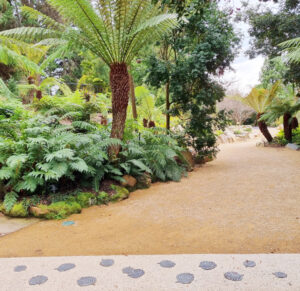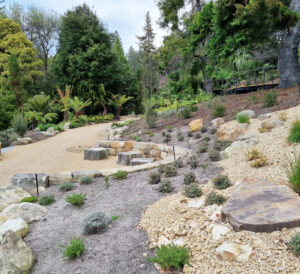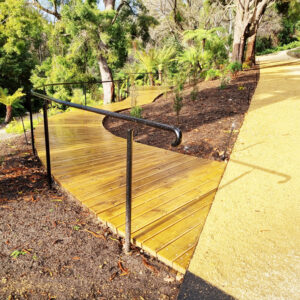
Introducing the Tasmanian Flora Entry Zone
By Chris Lang
The Tasmanian Native Section and adjacent areas have undergone substantial change in accordance with long held plans to redevelop Tasmanian flora displays through the northern region of the Royal Tasmanian Botanical Gardens. A significant landscaping effort, which commenced during September 2020, has resulted in the establishment of the Tasmanian Flora Entry Zone.
The Entry Zone, our in-house reference to the area, was deemed a priority for redevelopment following a severe storm event that struck the Gardens during May 2018. Thirteen mature trees were lost during the storm, including a large Pinus ponderosa (Ponderosa pine) specimen that fell across the sub-alpine/scree area of the Tasmanian Native Section, resulting in the loss of a significant number of valuable specimens, including some of the largest Athrotaxis (pencil pines) plants in cultivation.
The Entry Zone will function as a welcoming introductory experience for visitors as they embark upon an informative and educational journey of discovery through, a yet to be established, assemblage of interconnected, engaging Tasmanian native collection elements.

Our objective was to establish a display of Tasmanian native plants in a creatively designed contemporary setting, rather than trying to replicate natural bush landscapes. To help realise our vision, the services of a local landscaping contractor were employed to transform a previously uninspiring sloping site with poorly drained heavy black clay soil, into an aesthetically appealing landscape that supports the healthy growth of a broad variety of Tasmanian native plant species.
The new development is a landscape of two distinct styles. Plantings with a natural habitat focus transition within a relatively short distance, to a contrasting formal space. Visitors first make their way along a meandering gravel path through plantings reminiscent of Tasmania’s Cool Temperate Rainforest, where attractive combinations of iconic rainforest/wet forest species such as Lagarostrobos franklinii (Huon Pine), Atherosperma moschatum (Sassafras), Phyllocladus aspleniifolius (Celery-top Pine) and Richea pandanifolia subsp. pandanifolia (Pandani), combine with a lush, ferny understorey. Additional plantings of Nothofagus cunninghammii (Myrtle Beech) in this area flank the pathway, which will ultimately provide visitors with the opportunity to walk beneath their broad, cathedral like canopies.

Moving on from the naturalistic setting of the rainforest/wet forest, is the Ornamental Horticulture Presentation Space, where refreshing expressions of formal design principles, such as hedging, espalier and topiary shapes, will be displayed in a practical, functional space. We are keen to demonstrate that carefully selected Tasmanian native species can withstand rigorous horticultural practices, and can be used in a variety of ways to achieve desired effects. Species selected will mostly be those that have proven to perform well at the Gardens, including some that will be trialled for use in a different way, such as the espaliering of Acacia siculiformis (Dagger Wattle) and Banksia marginata ‘Coastal Spread’. We will also feature plants in a variety of containers, to further demonstrate the versatility of Tasmanian species suited to containerised approaches in gardens both large and small. Permanent container specimens will be located in this area, along with plants that have seasonal interest being cycled through from our nursery to ensure there is always something new and interesting on display. The Ornamental Horticulture Presentation Space provides an open, hard surfaced area with adequate seating, to comfortably accommodate larger group gatherings for educational purposes. This will enable both staff and trained volunteer guide educators to deliver presentations on a range of Tasmanian native flora themed topics, including the methods and techniques required to successfully grow Tasmanian native plants in cultivation.
Funding for the Ornamental Horticulture Presentation Space
Funding for the Ornamental Horticulture Presentation Space was made available through a successful Stanley Smith Horticultural Trust grant application. The Trust, based in the US, supports projects centred on education and research in ornamental horticulture through grants to botanical gardens, arboreta, universities, and other charitable organisations strongly aligned with its funding interests. Funding is provided for projects in North America, South America, Central America, the Caribbean and more recently, Australia and New Zealand. Stanley Smith (1907-1968) was a philanthropic Australian businessman with a passion for ornamental horticulture.
In common with any themed collection in a Botanic Garden, we want people to walk away with a better understanding and greater appreciation of Tasmania’s indigenous flora. The establishment of meaningful, engaging interpretation panels and sculptural elements, soon to be located throughout the Entry Zone, will significantly further that end. Interpreting the amazing qualities of species, their place in the wild and demonstrating their horticultural worth, helps better connect Tasmanians to their local, indigenous flora and importantly, the need to conserve it.
Chris Lang
Curator Tasmanian Flora
Royal Tasmanian Botanical Gardens
M: 040 864 2037
E: Christopher.lang@rtbg.tas.gov.au
